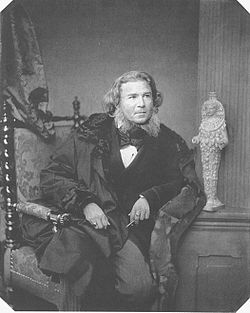Biography:Peter Ernst von Lasaulx
Peter Ernst von Lasaulx (German pronunciation: [laˈsoː]; March 16, 1805 – May 9, 1861) was a German philologist and politician.
Life
Lasaulx was born in Koblenz, and died in Munich. He was the eldest son of well-known architect, Johann Claudius von Lasaulx (1781–1848) and his wife, Anna Maria Müller (1781–1855). He was named for his grandfather, Peter Ernst Joseph von Lasaulx (1757–1809), who served as Syndic for Koblenz. Ernst's siblings included:
- Otto Phillip von Lasaulx (1806–1897) - emigrated to Fayette County, Texas in 1848 after serving as Bauinspektor in Elberfeld.
- Hermann von Lasaulx (1808–1868)
- Maria Anna von Lasaulx (1810–1866) - served as Superior of the Heiligen Geist Hospital in Luxembourg.
- Peter Francis von Lasaulx (1811)
- Clementine Maria von Lasaulx (1812–1877)
- Karl Adam von Lasaulx (1814–1815)
- Amalie von Lasaulx (1815–1872) - known as Sister Augustine, served as Superior of the St. Johannis Hospital in Bonn until she was removed due to conflict with doctrinal forces of the time.
- Katherina von Lasaulx (1817–1819)
Ernst's uncle was Johann Joseph von Görres, a well-known priest and writer, husband to aunt Catherine von Lasaulx.
At a young age, Ernst Lasaulx became fascinated with classical philosophy. He studied at Bonn (1824–1830) and then at Munich, where he focused on Schelling, Görres, and Baader, whose daughter he later married. After finishing his studies at the university, he spent the next four years traveling around Austria, Italy, Greece, and Palestine; visiting all the most important places from history. His trip to Athens was made as part of the party of Prince Otto of Wittelsbach, who had just been made King of the Hellenes
Returning to Germany, he received his doctorate from Kiel in 1835 with the dissertation "De mortis dominatu in veteres, commentatio theologica-philosophica", and was subsequently appointed to be docent of classical philology at the University of Würzburg. On August 31, 1835 he married Julie von Baader (1807-1880), a daughter of philosopher Franz Xaver von Baader (1765-1841). It is believed that Ernst and Julie had seven children.
Cologne in 1837
On November 20, 1837, Clemens August, Archbishop of Cologne, was arrested and imprisoned by the Prussian government. This sent a shock through Catholic circles throughout Germany, and inspired both Lasaulx and his uncle to write pamphlets. His, Kritische Bemerkungen über die Kölner Sache (Critical Remarks about the Cologne Matter), was a controversial attack on the Prussians in general and diplomat Josias von Bunsen in particular.
Although the Würzburg government tried to keep him there, Lasaulx left in 1844 to become Professor of Philology and Aesthetics at the University of Munich, where he became known for his magnetic style. He became involved in political matters, which resulted in the dismissal of Minister Abel in 1847, this made heads of the University happy, but Ludwig I quite upset. He dismissed Lasaulx from his post, and upon protests by the students, and eight other professors as well. Lasaulx and three other former Munich lecturers were elected to the national assembly in Frankfort, where he identified himself with the conservatives.
Montez Scandal
In 1848 Ludwig I was forced to abdicate over a scandal involving his mistress Lola Montez. His successor, Maximilian II gave in to public pressure and reinstated Lasaulx and the others to their old posts in 1849. Later that year, Lasaulx was elected to the Bavarian Chamber of Deputies. He served there until his death on May 9, 1861.
Works
In 1860, he dedicated his “Philosophy of Fine Arts" to Emilie Linder, a painter and intellectual in Munich.[1]
References
- ↑ Historische Commission bei der königl. Akademie der Wissenschaften (1883), "Linder, Emilie", Allgemeine Deutsche Biographie, Bd. 18, Allgemeine Deutsche Biographie (München/Leipzig: Duncker & Humblot): pp. 697, https://de.wikisource.org/wiki/ADB:Linder,_Emilie, retrieved 2021-04-02
![]() This article incorporates text from a publication now in the public domain: Herbermann, Charles, ed (1913). "Ernst von Lasaulx". Catholic Encyclopedia. New York: Robert Appleton.
This article incorporates text from a publication now in the public domain: Herbermann, Charles, ed (1913). "Ernst von Lasaulx". Catholic Encyclopedia. New York: Robert Appleton.
Further reading
- Tonsor, Stephen J. (1964). "The Historical Morphology of Ernst Von Lasaulx". Journal of the History of Ideas 25 (3): 374–392. doi:10.2307/2707905.


